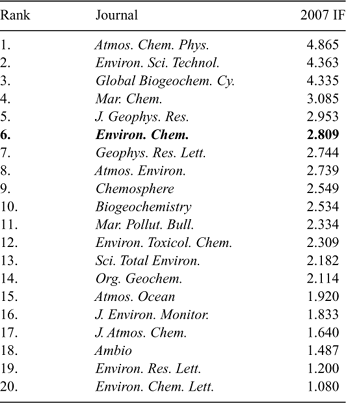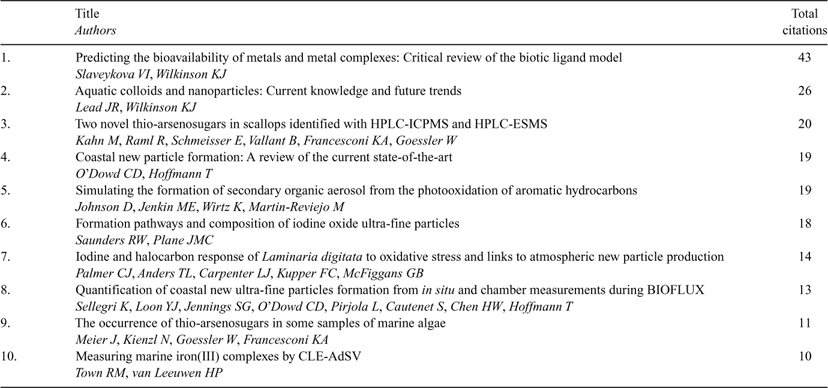Environmental Chemistry: Already having an Impact
Alison GreenEnvironmental Chemistry 5(4) i-iii https://doi.org/10.1071/EN08046
Published: 19 August 2008
Environmental Chemistry is placed in the top 15% of journals in the category of Environmental Sciences, according to Thomson ISI's Journal Citation Report for 2007.
Environmental Chemistry has received an Impact Factor (IF) of 2.8 from Thomson Scientific’s ISI Web of Knowledge (Thomson Reuters). In the category of Environmental Sciences, this IF places Environmental Chemistry 22nd out of 160 journals, and when the journal is compared with other environmental journals that have significant chemical content, including journals from other categories, such as Geosciences and Meteorology and Atmospheric Sciences it is ranked in the top six (see Table 1). Such a high position for a starting IF puts the journal in an excellent position to have a significant impact in the environmental sciences, and clearly shows the major role that the journal is already playing in the environmental sciences.

|
Thomson Scientific requires several years’ data before calculating a journal’s IF. Hence, a new journal entering the competitive publishing arena must try to establish itself without an external ‘objective’ assessment of its quality and impact. In this light, Environmental Chemistry’s IF of 2.8 is particularly good. It reflects the significance and importance of the work published so far (the most highly cited papers are listed in Table 2), and demonstrates that the journal fills a clear niche.

|
It is likely that the IF will have a strong positive impact on future submissions to Environmental Chemistry as the journal becomes better known and accepted as a leading journal by environmental scientists.
We have firm plans in place for the journal’s immediate growth and development:
-
We will continue publishing Research Fronts on emerging and topical issues in environmental chemistry.
-
Research Fronts are designed to be a forum for new results, analysis and opinions on established, but growing, topical areas of research. The aim with these series is to bring together the cutting edge of all aspects of an area, particularly on topics that cut across environmental boundaries or reservoirs. For example, in issue 2 this year, we published a Research Front on Mercury, with a focus on the Arctic region. The articles spanned the Arctic oceans,[1] atmospheric processes,[2] transport of mercury from Asia,[3] the role of mosquitoes in atmospheric mercury depletion events,[4] and health effects from exposure in humans.[5]
-
Research Fronts can also be more in the forum style, the recent CLAW Research Front simply bringing together a series of Opinion Essays from leaders in the field about the current state of research into dimethylsulfide (DMS) cycling and its relationship to climate. The series was opened with an editorial and an overview[6] of developments since publication of the CLAW hypothesis,[7] and closed with a synthesis of these opinions, and a discussion of possible future directions.[8]
-
Topics that will be covered in future Research Fronts include:
-
-
Speciation analysis in environmental research, providing an overview of current methods of analysis, their strengths and weaknesses, and which elements and matrices they are useful for.
-
Perchlorate in the environment, discussing the sources, fate and distribution, of perchlorate in the environment and related health issues.
-
Secondary organic aerosol, focusing on the formation, sources and impacts of secondary organic aerosol, particularly in unpolluted areas.
-
-
We welcome two new members to the Editorial Board of Environmental Chemistry – Professor Barry Huebert and Dr Jill Cainey. Their photos and short biographies and motivation for joining the Editorial Board are included in this editorial.
-
We introduce in the present issue a new type of article to Environmental Chemistry – the Concept article – to encourage and facilitate the publication of new ideas.
-
The aim of the Concept article is to present a new way of thinking about known phenomena, or a new interpretation of existing data. While the theory may not be fully proven, or accepted, there is significant evidence in support of the theory, and the author is able to present convincing arguments based on that evidence. Authors are encouraged to speculate, as long as it is based on sound reasoning. The very first Concept article is published in this issue – Martin Johnson and Tom Bell of the University of East Anglia present their novel ideas on coupling between DMS emissions and the ocean-atmosphere exchange of ammonia.[9]
-
The addition of the Concept article to the range of papers published in Environmental Chemistry broadens the journal’s appeal and further enhances our commitment to publishing leading-edge research, and to ensuring it reaches the relevant community rapidly. Many of the papers published in Environmental Chemistry are already well cited, demonstrating the relevance of the journal (Table 2).
The high, first IF of Environmental Chemistry also confirms CSIRO PUBLISHING’s conviction of the need for a journal in the environmental sciences that specialises in chemical processes. The journal covers a wide range of environmental aspects and issues, but these are always based on firm chemical data. Because environmental issues have direct and immediate consequences for our daily life, environmental research can readily lead to changes in local and, at times, global regulations impacting on the environment and on human health. Thus, the outcomes from environmental research can be extremely important, and hence it is imperative that the data are rigorously assessed. Environmental Chemistry strives to deliver these data in a clear, concise manner that is of interest to chemists, while also being understandable and accessible to a wider readership. Environmental Chemistry fills a niche in the environmental sciences. It has performed strongly in its early years and is now well placed to build on its impressive first IF and establish itself as the leading journal reporting chemical processes in the environment.
Alison Green
New board members on why they joined
‘Environmental Chemistry is an exciting journal which is directly relevant to my research interests in the role of micro- and macro-algae in particle formation and cloud formation. The journal has a good reputation and provides rapid publication of peer-reviewed papers that means quality research is quickly disseminated to the scientific community. I had the pleasure of working on two Research Fronts in Environmental Chemistry and was very keen to be more involved in the journal.’ Jill Cainey
‘I see Environmental Chemistry as a different type of journal, looking for new ways to engage readers in conversations about issues. The CLAW issue is a perfect example, in which the Editors sought multiple opinions on this important potential feedback loop. There are lots of web journals around now, but few that so proactively seek multiple points of view.’ Barry Huebert

|
[1]
P. M. Outridge ,
R. W. Macdonald ,
F. Wang ,
G. A. Stern ,
A. P. Dastoor ,
A mass balance inventory of mercury in the Arctic Ocean.
Environ. Chem. 2008
, 5, 89.
| Crossref | GoogleScholarGoogle Scholar |

[2]
I. M. Hedgecock ,
N. Pirrone ,
F. Sprovieri ,
Chasing quicksilver northward: mercury chemistry in the Arctic troposphere.
Environ. Chem. 2008
, 5, 131.
| Crossref | GoogleScholarGoogle Scholar |

[3]
D. Jaffe ,
S. Strode ,
Sources, fate and transport of atmospheric mercury from Asia.
Environ. Chem. 2008
, 5, 121.
| Crossref | GoogleScholarGoogle Scholar |

[4]
C. R. Hammerschmidt ,
W. F. Fitzgerald ,
Methylmercury in arctic Alaskan mosquitoes: implications for impact of atmospheric mercury depletion events.
Environ. Chem. 2008
, 5, 127.
| Crossref | GoogleScholarGoogle Scholar |

[5]
A. L. Choi ,
P. Grandjean ,
Methylmercury exposure and health effects in humans.
Environ. Chem. 2008
, 5, 112.
| Crossref | GoogleScholarGoogle Scholar |

[6]
G. P. Ayers ,
J. M. Cainey ,
The CLAW hypothesis: a review of the major developments.
Environ. Chem. 2007
, 4, 366.
| Crossref | GoogleScholarGoogle Scholar |

[7]
R. Charlson ,
J. Lovelock ,
M. Andreae ,
S. Warren ,
Oceanic phytoplankton, atmospheric sulphur, cloud albedo and climate.
Nature 1987
, 326, 655.
| Crossref | GoogleScholarGoogle Scholar |

[8]
J. M. Cainey ,
H. Sievering ,
G. P. Ayers ,
Where to now? A synthesis of current views of the CLAW hypothesis.
Environ. Chem. 2007
, 4, 406.
| Crossref | GoogleScholarGoogle Scholar |

[9]
M. T. Johnson ,
T. G. Bell ,
Coupling between DMS emissions and the ocean-atmosphere exchange of ammonia.
Environ. Chem. 2008
, 5, 259.
| Crossref | GoogleScholarGoogle Scholar |



